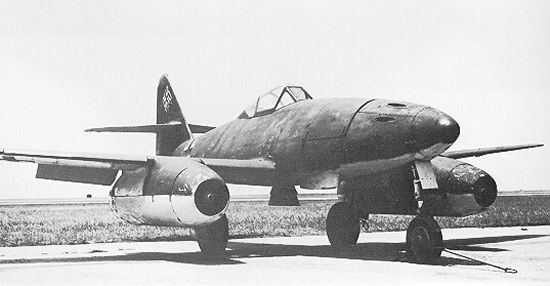|
||||||||||
|
|
||||||||||
|
||||||||||
|
|
||||||||||

The flight during which Mutke believes he flew supersonic occurred on 9 April 1945. He had been instructed to perform a training mission at high altitude, so Mutke climbed to about 36,000 ft (11,000 m) after takeoff. Shortly thereafter, he overheard a flight controller warning about a P-51 Mustang that was closing in on one of Mutke's fellow trainees. Mutke decided to fly to the aid of his colleague and pushed the plane into a steep left bank to dive towards the intruding Allied fighter. Within seconds, the plane began vibrating violently as the tail was buffeted back and forth. His airspeed indicator had maxed out at 684 mph (1,100 km/h), the nose pitched down sharply, and the plane was no longer controllable. Mutke said he was only able to regain control by changing the angle of the Me 262's horizontal stabilizer. This action helped him to reduce his speed to 310 mph (500 km/h) and pull out of the dive.
Mutke came forward with his story in the 1990s when he claimed that the behaviors he had seen must mean he had exceeded the speed of sound. It is true that pilots of early jet aircraft often reported extreme vibrations and buffeting when approaching the sound barrier. This behavior is caused by the creation of shock waves that begin forming over the wings and stabilizer surfaces in transonic flight. The transonic region is a flight regime where some parts of a plane are traveling supersonic while others are subsonic. For example, the overall airspeed of a plane could be Mach 0.95, or 95% of the speed of sound, but the air accelerating around some parts of the plane, like the wing, may be moving faster than Mach 1. Once the airflow reaches Mach 1 over any part of the plane, a shock wave will be created that can drastically change the plane's flight characteristics. This mixture of subsonic and supersonic flow around a vehicle usually occurs over a range of airspeeds from Mach 0.7 to Mach 1.3, which is what we consider to be the transonic regime.

Mutke also mentions his plane's control problems, which were frequently seen on other transonic aircraft as well. One of the key problems he notes is the tendency of the nose to pitch down, a factor caused by the creation of shock waves over the wing that shift its center of lift aft. We discussed this phenomenon in a previous article about mach trim. Furthermore, Mutke mentions that he had no ability to overcome this pitch behavior by deflecting the plane's elevator control surface. The problem occurs because shock waves often cause flow separation over conventional elevators and make the surfaces ineffective.
Another factor that Mutke discusses is the unusual behavior of his airspeed indicator that appeared to go off the scale. This is another effect that often occurs in transonic flight because shock waves interfere with the pressure probes used to measure airspeed. This behavior was not well understood by early supersonic researchers, and new compressibility corrections had to be applied to pitot tube data to provide accurate airspeed measurements at transonic and supersonic speeds.
In other words, all of the behaviors that Mutke observed on his flight are consistent with factors that are known to exist at transonic speeds, but does that mean he broke the sound barrier? Not necessarily, because we have seen that all of these behaviors can exist well below the speed of sound itself. Many pilots of older propeller planes powered by piston engines had also encountered these same phenomena at speeds as low as Mach 0.5, and the same problems afflicted many of the early experimental rocket and jet aircraft like the X-1 and de Havilland D.H.108 well before reaching Mach 1.

Also important to note are the findings of Willy Messerschmitt who had designed the Me 262. Messerschmitt conducted a detailed series of wind tunnel and flight tests to determine the maximum speed his creation could achieve. Flight tests included a series of dives similar to that experienced by Hans Mutke. Messerschmitt concluded that the Me 262 could not exceed Mach 0.86 without becoming completely uncontrollable. Any higher Mach number would generate a nose-down pitch so strong that the pilot would not be able to overcome it. This pitch would constantly increase the plane's dive angle to the point that the aircraft would disintegrate under the negative g-loads. The Royal Aircraft Establishment in the United Kingdom later confirmed these findings during Britain's evaluation of the Me 262 after the war. The RAE found that the maximum safe speed that could be attained was Mach 0.84, and any higher speed would result in a fatal, uncontrollable dive from which recovery was not possible.
In light of this information, it seems very unlikely that Hans Mutke broke the sound barrier in 1945 while flying the Me 262. If he had, he would not have lived to tell the tale. Mutke probably reached speeds closer to Mach 0.85. It seems probable that he experienced the sudden changes in flight characteristics that often occur in transonic flight and believed he had flown faster than was actually possible.
For further information, Hans Mutke's first-hand
account of his flight is entertaining to read,
particularly his rather bizarre analogies between breaking the speed of sound and giving birth or losing one's
virginity!
- answer by Joe Yoon, 17 October 2004
Related Topics:
Who was the first Brit to break the sound barrier, and when did it occur?
When did Russia first break the sound barrier? Who did it and in what plane?
Who was the first person to fly Mach 2?
Read More Articles:


|
Aircraft | Design | Ask Us | Shop | Search |

|
|
| About Us | Contact Us | Copyright © 1997- | |||
|
|
|||